The use of doubled haploids in maize breeding was first proposed more than half a century ago. Today, the in vivo haploid induction technique is routinely used in maize inbred line development, in both the public and the private sector. The DH technology enhances maize breeding in two ways: 1) it reduces the time required to produce completely homozygous inbred lines. Whereas six or more generations of self-pollination are needed to traditionally produce inbreds, DH technology produces inbreds in only two generations; and 2) because the higher genetic variance among DH lines compared to F2 plants, or selfed F3 or F4 families, improves the effectiveness of selection.
DH technology in maize breeding was the theme of a training workshop organized by the University of Hohenheim (UH) and CIMMYT at Stuttgart, Germany, during 11-15 June 2012. The program was organized under the ‘Abiotic stress tolerant maize for Asia’ (ATMA) project funded by Deutsche Gesellschaft für Internationale Zusammenarbeit (GIZ). A total of 21 scientists, including maize breeders and physiologists from Bangladesh, India, Philippines, Vietnam, UH, and CIMMYT attended the weeklong course. Experts on DH technology from UH, CIMMYT, and German seed companies served as resource persons on the course, delivering lectures on various aspects of DH technology in maize breeding. Mornings were devoted to lectures whilst in the afternoons, participants undertook hands-on, practical project in various aspects of DH line development and production.
Day-1 presenters included UH’s Wolfgang Schipprack; Vanessa Prigge, an ex-PhD student of UH and CIMMYT who is currently working as a Potato Breeder in SaKa Pflanzenzucht GbR, and T. Wegenast, Dow AgroSciences. In the afternoon, participants worked on identification of haploid kernels from various DH-induced populations and planted haploid kernels on germination paper for development of seedlings. DH lab members at UH explained and demonstrated the selection of haploid kernels and developing seedlings for colchicine treatment for chromosome doubling.
On the second day, B. Schilling and B. Devezi of the UH-DH lab jointly presented various aspects of management of greenhouses, safety issues, and requirements for running a successful DH program. E. Senger a PhD student at UH, and Vijay Chaikam, CIMMYT, also shared their experiences. During the afternoon, preparation of colchicine solution, preparation of maize seedling for colchicine treatment, application of colchicine treatment, and the transplanting the seedlings in greenhouse were demonstrated to the participants.
Participants also visited the UH-DH research station at Eckartsweier, where Schipprack detailed various field based aspects of DH development including selection of plants for transplanting in field, organized demonstration of mechanized transplanting of D0 plants, management of D0 nursery, and identification of false positives in the nursery. After the D0 nursery, participants visited the DH inducer development and maintenance nursery, D2 nurseries, and the isolation block for production of induction crosses. On the final day of the workshop, UH’s A.E. Melchinger delivered a lecture on the application of marker-based prediction strategies for DH lines and discussed various models and approaches for prediction of DH lines. George Mahuku shared updates on DH line production and development of tropical inducer lines at CIMMYT, and talked about possible models for use of DH technology by national breeding programs in Asia. Participants appreciated the initiatives and efforts of CIMMYT and UH, and discussed various options to get DH technology into their breeding programs.
Avinash Singode, Directorate of Maize Research, Bhagya Rani Banik, Bangladesh Agriculture Research Institute, and Le Quy Kha, National Maize Research Institute, were very supportive of the course and expressed their sincere thanks to organizers. P.H. Zaidi, Project Coordinator, ATMA, thanks Prof. Melchinger and Schipprack and his team for their time, efforts, and inputs in jointly organizing the workshop, and emphasized the need to follow up on this in the hope that within one year, each participating institution will have access to DH technology in their program, at least through Model-1 (send their most elite population to CIMMYT, and get back DH lines), as suggested by Mahuku.
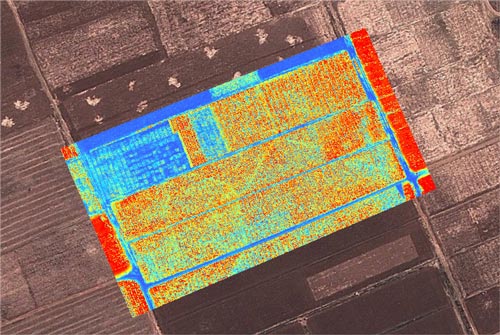 To free phenotyping of the varietal development bottleneck label, many new tools have been developed to enable an easier plant growth and development characterization and field variability. Until recently, these tools’ potential has been limited by the scale on which they can be used, but this is changing: a new affordable field-based phenotyping platform combining cutting edge aeronautics technology and image analysis was developed through collaboration between researchers from the University of Barcelona, Spain; Crop Breeding Institute, Zimbabwe; Instituto Nacional de Innovación Agraria, Peru; AirElectronics; and Sustainable Agricultural Institute of the High Research Council, Spain. The project was funded by MAIZE CRP as part of Strategic Initiative 9 activities focusing on new tools and methods for national agricultural research systems and small and medium enterprises to increase genetic gains in maize breeding.
To free phenotyping of the varietal development bottleneck label, many new tools have been developed to enable an easier plant growth and development characterization and field variability. Until recently, these tools’ potential has been limited by the scale on which they can be used, but this is changing: a new affordable field-based phenotyping platform combining cutting edge aeronautics technology and image analysis was developed through collaboration between researchers from the University of Barcelona, Spain; Crop Breeding Institute, Zimbabwe; Instituto Nacional de Innovación Agraria, Peru; AirElectronics; and Sustainable Agricultural Institute of the High Research Council, Spain. The project was funded by MAIZE CRP as part of Strategic Initiative 9 activities focusing on new tools and methods for national agricultural research systems and small and medium enterprises to increase genetic gains in maize breeding.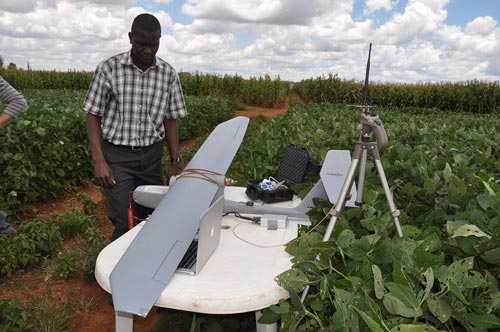 The new platform uses ‘Sky Walker,’ an unmanned aerial vehicle which can fly at over 600-meter with an average speed of 45 km/h. The vehicle has thermal and spectral cameras mounted under each wing, and its flight path and image capturing are controlled via a laptop using Google Earth images. Jill Cairns and Mainassara Zaman-Allah tested the platform at CIMMYT-Harare along with José Luis Araus (University of Barcelona), Antón Fernández (AirElectronics president), and Alberto Hornero (Sustainable Agricultural Institute of the High Research Council) to establish the optimal flight path (distance between plane passes and height) for plot level measurements. Field experiments were phenotyped for spectral reflectance and canopy temperature within minutes; these will be compared to results from the GreenSeeker.
The new platform uses ‘Sky Walker,’ an unmanned aerial vehicle which can fly at over 600-meter with an average speed of 45 km/h. The vehicle has thermal and spectral cameras mounted under each wing, and its flight path and image capturing are controlled via a laptop using Google Earth images. Jill Cairns and Mainassara Zaman-Allah tested the platform at CIMMYT-Harare along with José Luis Araus (University of Barcelona), Antón Fernández (AirElectronics president), and Alberto Hornero (Sustainable Agricultural Institute of the High Research Council) to establish the optimal flight path (distance between plane passes and height) for plot level measurements. Field experiments were phenotyped for spectral reflectance and canopy temperature within minutes; these will be compared to results from the GreenSeeker.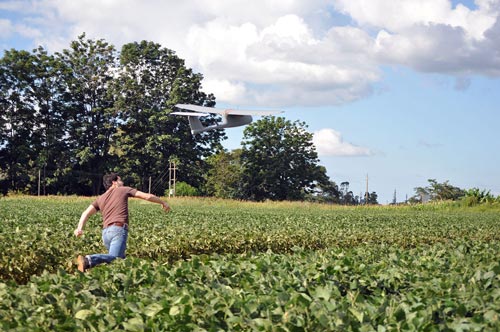
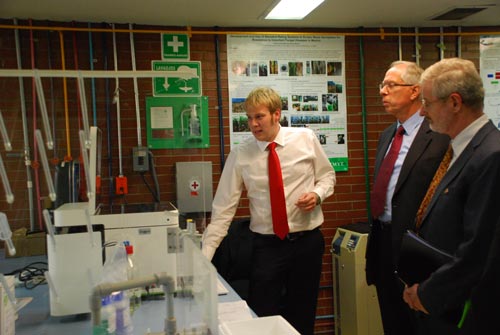 allow speedy DNA analysis for breeding. “With this new technology, we save tremendous amounts of money, time, and resources. We’re really grateful to
allow speedy DNA analysis for breeding. “With this new technology, we save tremendous amounts of money, time, and resources. We’re really grateful to 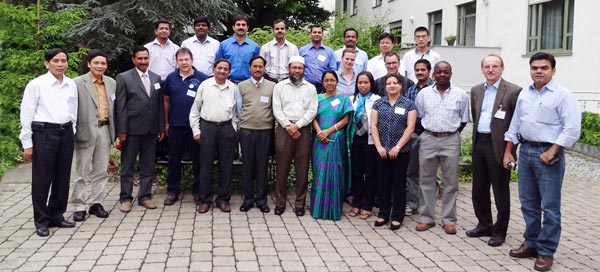
 Tom Payne, head of the CIMMYT wheat collection in the Wellhausen-Anderson Genetic Resources Center will be heard on the stations of National Public Radio in the United States later this month. He was interviewed this week for a story about the launching of a new genebank project in Norway. The interview was conducted over the telephone by NPR journalist Dan Charles from a studio in Washington DC. NPR sent their Mexico City journalist, Karina Pais to record Tom’s answers to the questions.
Tom Payne, head of the CIMMYT wheat collection in the Wellhausen-Anderson Genetic Resources Center will be heard on the stations of National Public Radio in the United States later this month. He was interviewed this week for a story about the launching of a new genebank project in Norway. The interview was conducted over the telephone by NPR journalist Dan Charles from a studio in Washington DC. NPR sent their Mexico City journalist, Karina Pais to record Tom’s answers to the questions.